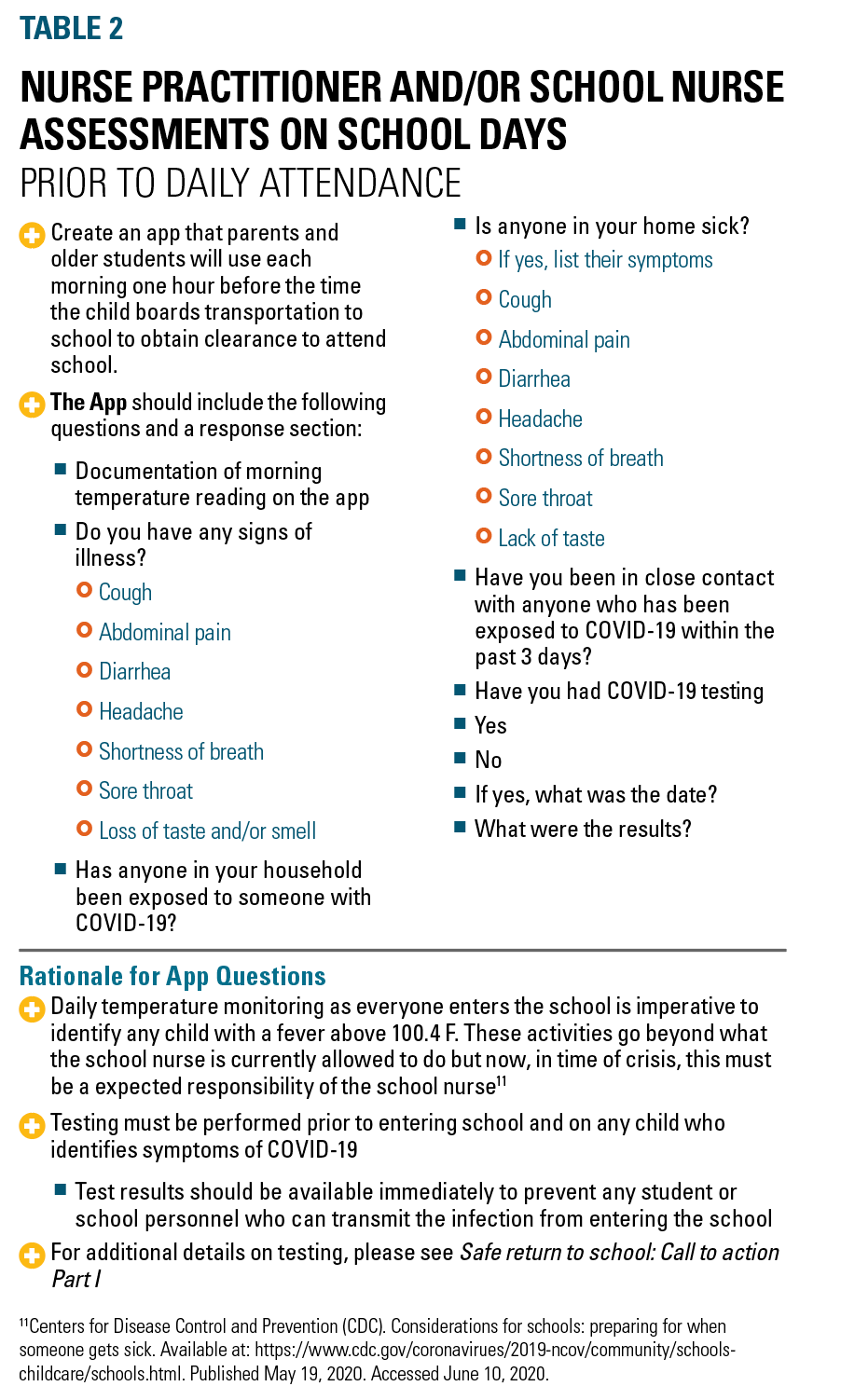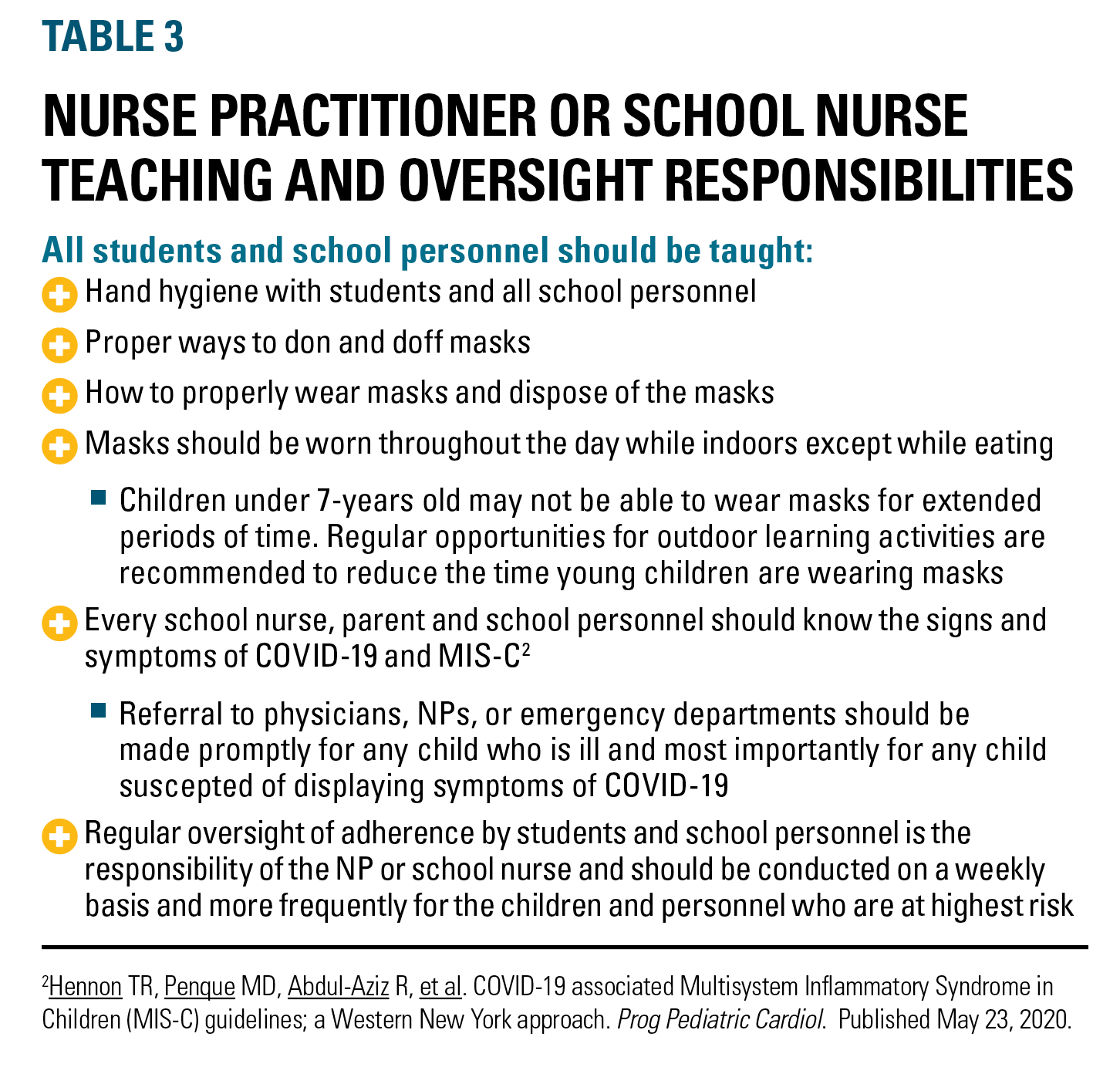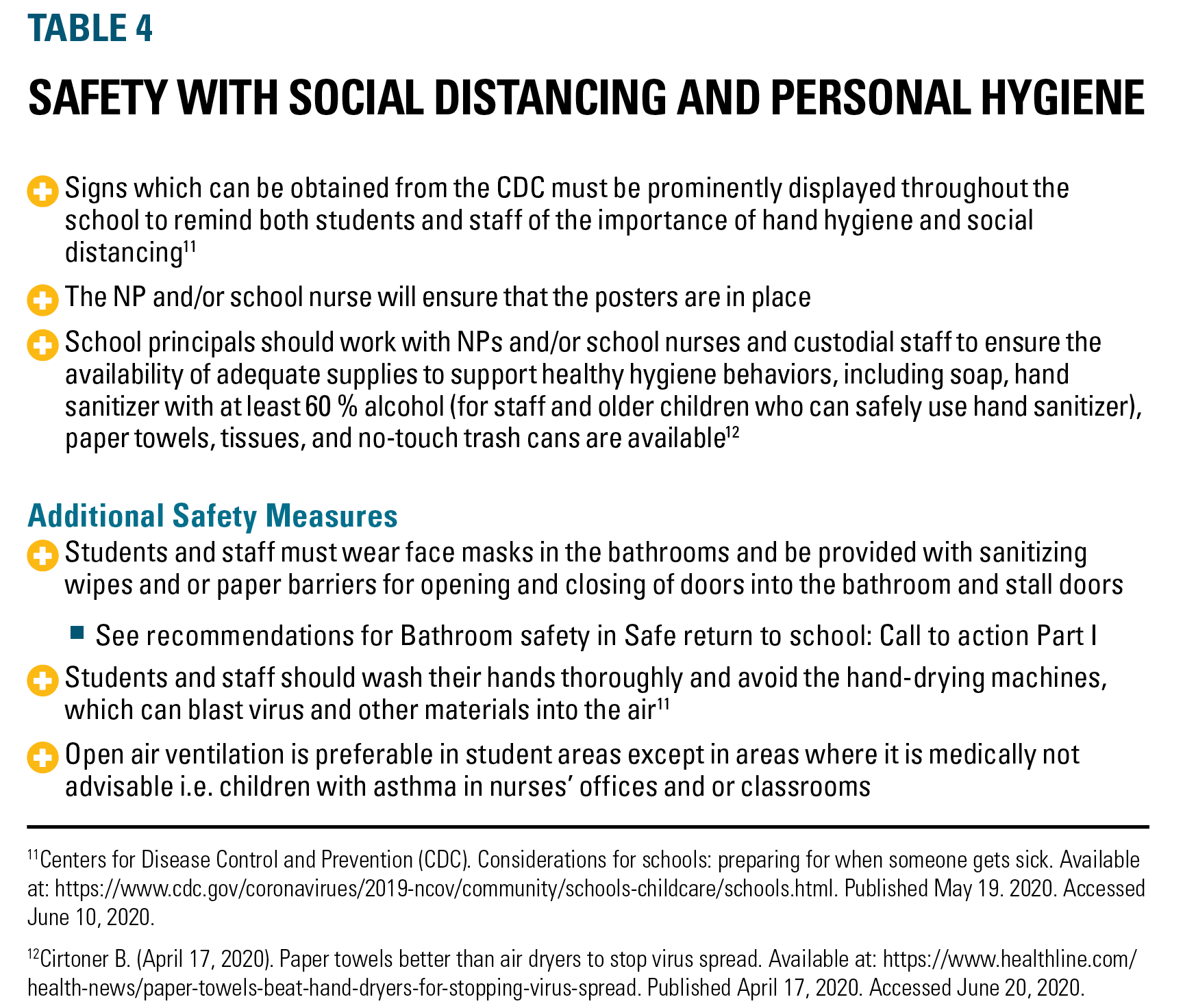- Pharmacology
- Allergy, Immunology, and ENT
- Cardiology
- Emergency Medicine
- Endocrinology
- Adolescent Medicine
- Gastroenterology
- Infectious Diseases
- Neurology
- OB/GYN
- Practice Improvement
- Gynecology
- Respiratory
- Dermatology
- Mental, Behavioral and Development Health
- Oncology
- Rheumatology
- Sexual Health
- Pain
Safe return to school: Part 2
As fall approaches, one of the biggest questions is: Can children return to school and be in classroom environments that assure health and well-being for all? Here's how practitioners can help.
Over the past 20 years, pediatric and family nurse practitioners (PNPs & FNPs) have been providing primary health care services to children whose lives are often challenged by the social determinants of health (SDOH).1 COVID-19 has adversely impacted the health and well-being of grandparents, parents and close relatives of these children, with an overwhelming number of their relatives succumbing to COVID-19. In the last week of April 2020, the emergence of a new disorder, Multisystem Inflammatory Syndrome in Children (MIS-C)2 was identified in the United States (US) and the United Kingdom, and disproportionately affects children in these vulnerable, multi-ethnic, minority communities.3 Thus, because COVID-19 has demonstrated how adversely it can affect children, critical decisions must be made on the topic of safe ‘return to school.’
The practice of school nursing began in the United States on October 1, 1902, when Lina Rogers, the first school nurse, was hired to reduce absenteeism by intervening with students and families regarding healthcare needs related to communicable diseases.4 One hundred and eighteen years later, in the midst of the COVID-19 pandemic, school nurses still play a critical role in the totality of the management of health, including the prevention and control of transmission of this novel COVID-19 virus for all who return to school, not only the children. Today, school nurses are not limited to the care of children in vulnerable communities. School nurses have leadership roles overseeing the healthcare needs of children and school personnel in schools throughout the United States. The COVID-19 pandemic brings to the forefront the need for legislation that requires every school, throughout the US, to employ an on-site registered nurse (RN). In 2016, the American Academy of Pediatrics recommended that schools have at least one registered available in each school to meet the health needs of the children.5
During the 2015-2016 school year, 52 % of public schools had a full time school nurse. Three-quarters or 82% of the schools had a at least one full time or one part time school nurse.5 Thus, school districts that do not have, at a minimum, a RN to oversee the day-to-day healthcare assessments of each child and school personnel will be at a disadvantage over schools that have a nurse to assess the children and staff for COVID-19 risks and make determine appropriate interventions.6 Preparation for return of to school for children with chonic illnesses, (eg, asthma, diabetes mellitus, congenital heart disorders) and children from vulnerable communities adversely affected by the social determinants of health (SDOH) will require NPs in School Based Health Centers (SBHCs) to work alongside school nurses to ensure the health, well-being and safety of both students and school personnel. Nurse practitioners are educationally prepared to critically analyze local COVID-19 data and to share and discuss the analysis with key administrators and school nurses. Shared decision making is a key component in the process of protecting the health of each individual and the entire school community. Nurse practitioners are also prepared to educate school nurses, all personnel, parents and children on the COVID-19 virus, including the most common presenting COVID-19 symptoms and MIS-C, as well as all of the safety precautions that must be in place prior to reopening schools.2 Nurse practitioners and school nurses are integral to the safe reopening of schools.
Children at increased risk for COVID-19 complications
Extrapolating data for the adult population for children who are chronically ill children, in particular, those with asthma, diabetes mellitus type 1 and 2, heart disease, kidney disease or sickle cell disease, immune compromised children, obese children and anecdotally, adolescents who practice risky behaviors, eg, vaping, or illicit drug use, are at-higher risk than the general pediatric population for complications from COVID-19. Plans for return to school must take into consideration whether the school environment can be designed as a safe environment for these high-risk children. Discussions with the entire team, including parents and older children, teachers, and school administrators must take place to decide on an individual basis whether the child/adolescent can safely return to school.
Update children’s immunizations and physical assessments
The CDC released data from the analysis of the Vaccine For Children (VFC) distribution of immunizations throughout the United States that revealed a significant decrease in the numbers of vaccines ordered by providers when comparing vaccines ordered from VFC during January 7, 2019 to April 21, 2019 to the numbers of vaccines ordered from Januaray 6, 2020 to Aprinl 19, 2020.5 Children aged 24 months and older, were most affected during the first 3-months of the COVID-19 pandemic during the time that parents followed the stay-at-home orders that were in place across the country.7 Now is the time for NPs and school nurses to be vigilant when reviewing immunization and physical exam records. Schools and children do not need the additional crisis of unimmunized or underimmunized children contracting a vaccine preventable disease (VPD) during the pandemic.8
Nurse practitioners can conduct telehealth and telemedicine visits which are suitable for assessing the child’s physical status for return to school.9 Nurse practitioners in SBHCs can perform a physical assessment once school is in session for children who receive their care in SBHCs. For children who need immunization updates, NPs may offer ‘drive-in parking lot immunization updates’ prior to school openings. Parents can visit local pharmacies that offer on-site immunization updates. Children seen in private pediatric offices or community clinics can contact their providers to be seen at their practices sites. Guidance and best practices for NPs and school nurses to support the safety of students and staff return to school is presented in the following tables.
Table 1

Table 2

Table 3

Table 4

Discussion
Planning, assessing, reassessing, and evaluation of potential problems are all critical components of return to school policies that focus on the health and well-being of the children and school personnel. In the COVID-19 pandemic, school nurses should be considered essential personnel for each school.13 Nurse practitioners or school nurses are needed to oversee implementation of public health initiatives to maintain a safe school environment (See Safe return to school: Call to action part 1). These initiatives include masks for all children and school personnel, monitor screening results before child enters school, and monitoring COVID-19 test results of children and school personnel. Management of ill children should be a top priority of every NP and school nurse.
School nurses should work closely with local Departments of Health for contact tracing when a child’s test result is positive for COVID-19.12
Conclusions
Nurse practitioners and school nurses play a critical role in the assessment and management of the health care needs of all children and personnel in school systems. Every school, that does not currently have a school nurse as a member of their team, should consider employing a RN to provide the complex assessments that must be implemented to assure the safety of each person who enters the school. School nurses routinely assess school health records, as well as the immunization status and physical examinations of children and take appropriate actions when children are not in compliance with school regulations. School nurses will have even greatere responsibilities during this pandemic. School nurses will have an important role in monitoring best practices for clearing children/adolescents and school personnel to come to school each day. In addition, school nurses will be working with local Departments of Health in the assessment of possible exposures of children or families to COVID-19 with the critical role of prevention of the spread within the school community. The school nurse and NPs will also play a role in the implemnentation and evaluation of safety precautions necessary for personal hygiene, social distancing, and proper wearing of masks and eye protections. The entire medical community, including physicians, NPs, school nurses, and local departments of health are valuable members of the return to school team with the overall goal of health and safety for all children and school personnel.
Acknowledgements: Based on the overall concern for the children we care for on a daily basis, five PNPs formed a ‘think tank’ engaging in weekly discussions on the preparation for return to school and authored two articles for this edition of Contemporary Pediatrics. In addition to the authors of this manuscript, significant contributors to this work were made by Regena Spratling, PhD, RN, APRN, CPNP, FAANP and Emily T. Cupelli, DNP, CPNP, BCB-PMD. Both are authors for the manuscript Safe return to school: Call to action, Part 1.
References
1. Love HE, Schlitt J, Soleimanpour S, Panchal N, Behr C. Twenty years of school based health care growth and expansion. Health Affairs. 2019. 38(5). 755-764. https://www.healthaffairs.org/doi/pdf/10.1377/hlthaff.2018.05472
2. Hennon TR, Penque MD, Abdul-Aziz R, et al. COVID-19 associated Multisystem Inflammatory Syndrome in Children (MIS-C) guidelines; a Western New York approach. Prog Pediatric Cardiol. Published May 23, 2020. Accessed June 26, 2020.
3. Heale T. COVID-19-related inflammatory condition more common in black kids in small study. Medscape Nurses. Published June 5, 2020. Accessed June 26, 2020. https://www.medscape.com/viewarticle/931847
4. Buswell SA, Lechtenberg J, Hinkson E, et al. National Association of School Nurses (NASN). The role of the 21st century school nurse. (Position Statement). Silver Spring, MD. 2016. Accessed June 26, 2020. https://www.nasn.org/advocacy/professional-practice-documents/position-statements/ps-role
5. AAP Council on School Health. Role of the School Nurse in Providing School Health Services. Pediatrics. Published June 2016. Accessed July 12, 2020. Accessed from https://pediatrics.aappublications.org/content/137/6/e20160852
6. Nelson L, McIlraith T. Coronavirus highlights school nurse role in public health preventions and response. Washington State Nurses Association. Published May 6, 2020. Accessed July 12, 2020. Accessed from https://www.wsna.org/news/2020/coronavirus-highlights-school-nurse-role-in-public-health-prevention-and-response
7. Centers for Disease Control and Prevention (CDC). Santoli J, Lindley MC, DeSilva MB, et al. Effects of the COVID-19 pandemic on routine pediatric vaccine ordering and administration. Published May 8, 2020. Accessed TK. Available at: https://www.cdc.gov/mmwr/volumes/69/wr/mm6919e2.htm#F1
8. Centers for Disease Control and Prevention (CDC). Maintaining childhood immunizations and well-child care during COVID-19 pandemic. Published May 20, 2020. Accessed June 25, 2020. https://www.cdc.gov/coronavirus/2019-ncov/hcp/pediatric-hcp.html?deliveryName=USCDC_2070-DM25408.
9. Mendoza MA, Ea E, Tilley C, et al. Telemedicine: Using technology to deliver healthcare at a distance. In Hallas, D. website: An innovative Academic-Clinical Partnership: Primary Care Nurse Practitioner Preceptor Development Program (PC-NP-PDP). Published May 2020. Accessed June 27, 2020. https://pdp.nursing.nyu.edu/education
10. Blad E. How CDC Guidance Could Shape What Back-to-School Looks Like in the COVID-19 Era. Education Week. Available at: https://www.edweek.org/ew/articles/2020/05/29/how-cdc-guidance-could-shape-what-back-to-school.html. Published May 29, 2020. Accessed June 20, 2020.
11. Centers for Disease Control and Prevention (CDC). Considerations for schools. Preparing for when someone gets sick. Published May 19. 2020. Accessed June 10, 2020. Available at: https://www.cdc.gov/coronavirues/2019-ncov/community/schools-childcare/schools.html.
12. Cirtoner B. (April 17, 2020). Paper towels better than air dryers to stop virus spread. Published April 17, 2020. Accessed June 20, 2020. Available at: https://www.healthline.com/health-news/paper-towels-beat-hand-dryers-for-stopping-virus-spread.
13. Thompson D. (June 11, 2020). Will schools reopen this fall? And what will that look like? Published June 11, 2020. Accessed June 25, 2020. Available at: https://www.medicinenet.com/script/main/art.asp?articlekey=234690&ecd=mnl_day_061120.
14. Servick K. (May 21, 2020). COVID-19 contact tracing apps are coming to a phone near you. How will we know whether they work? Science. Available at: https://www.sciencemag.org/news/2020/05/countries-around-world-are-rolling-out-contact-tracing-apps-contain-coronavirus-how. Published May 21, 2020. Accessed June 10, 2020.

Meet the Board: Vivian P. Hernandez-Trujillo, MD, FAAP, FAAAAI, FACAAI
May 20th 2022Contemporary Pediatrics sat down with one of our newest editorial advisory board members: Vivian P. Hernandez-Trujillo, MD, FAAP, FAAAAI, FACAAI to discuss what led to her career in medicine and what she thinks the future holds for pediatrics.
